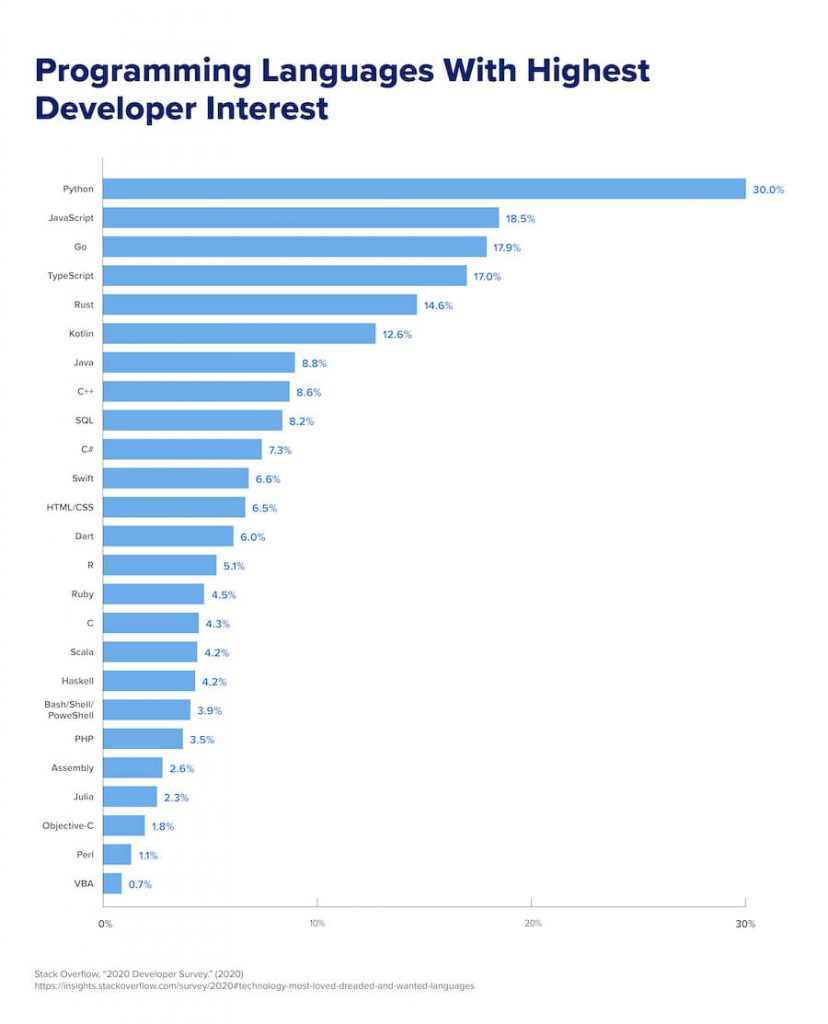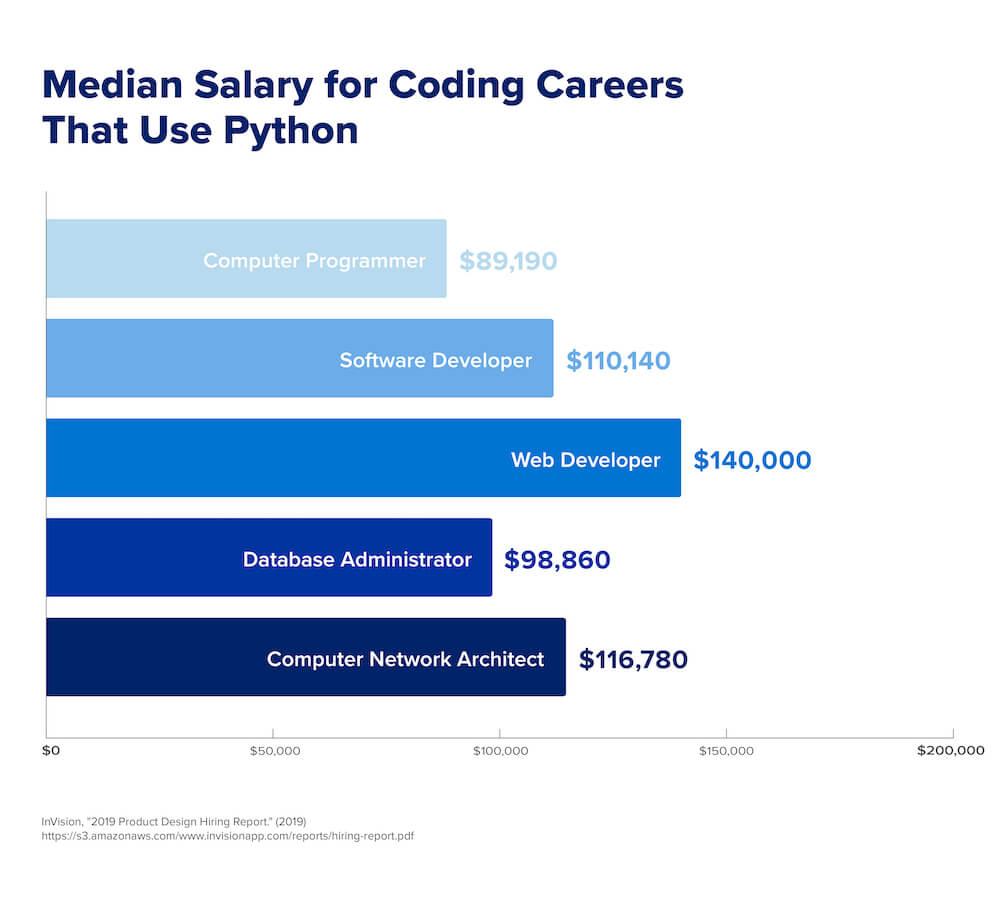Python and Its Basics: A Beginner’s Guide (2021)

Computer programmers use hundreds of languages to develop software and mobile applications, build websites, and teach computers how to learn. Because it performs all of those functions, Python is among the most popular and important programming languages for aspiring coders and accomplished developers to learn.
Python is a versatile programming language that employers find highly attractive; it can open doors whether you’re looking for a new job, seeking to grow your skills, or hoping to switch industries entirely.
In this article, we’ll explore the Python basics, including answers to the following questions:
- What is Python?
- What can you do with Python?
- What are Python’s basic uses?
- Which careers benefit from a working knowledge of Python?
Read on to learn more about this well-loved programming language.
What is Python?
Python is a multipurpose, high-level, object-oriented programming language — three properties that make it popular with coders and developers. Python is multipurpose because it can be used to create software and apps, design websites, and automate repetitive tasks. Web developers and data scientists like Python for its broad range of companion libraries, accessible syntax, and portability. The library tools and packages help developers shorten and streamline their coding time, and many programmers appreciate that Python requires less time to build projects.
As a high-level language, Python uses an easy-to-read command syntax that it converts to machine code. It also works on the Mac, Windows, and Linux platforms, making it accessible to nearly every programmer.
As an object-oriented language, Python organizes programs into objects and classes that can be reused throughout a project.
Object-Oriented Programming
In object-oriented programming, related variables and functions are grouped into units (or objects). These objects contain data and procedures that determine how they act. In Python, everything is considered an object — and functions are created to determine objects’ actions.
Python Basics: How Does Python Work?
While Python has become an essential language and a very useful skill for data analysts, it requires some basic terminology to get started. If you have a limited programming background, here are a few important terms to know:
Comments
Use a hashtag to leave comments, or notes, to yourself or others explaining elements of your code. In Python, comments are ignored so they are not incorrectly included in the final product.
Keywords
Every programming language relies on certain words to convey meanings or perform specific functions. For example, True and False are used to represent the truth value of an expression within the Python Boolean, one of Python’s built-in data types.
Built-in Data Types
Because variables can store different types of data, it’s important to input the correct data types while programming. Python uses several data types, including numerics, strings, Booleans, lists, and tuples.
Loops
Loops simplify the process of repeating an action for a specific number of steps or until a condition is met. Python presents two types of loops when code needs to be repeated: for and while.
How to Install Python
Python is simple to install; in fact, it might already be installed on your computer. To check, open a command-line window and type “Python.” If the language is installed, a Python interpreter will respond by showing a version number. If not, a link to a free download will likely appear.
If you need to download Python, the language’s free site offers instructions to easily download the latest version for Windows, Mac OS, and Linux.
Here are a few more key related terms to be familiar with as you get started using Python:
Conditionals
Generally speaking, conditional statements facilitate decision-making within a program and perform an action depending on whether a defined condition is true. The primary conditional commands in Python are if and else. Since Python supports common math conditions (e.g., a = 1, b = 2, b > a), the if and else commands deliver instructions based on those conditions. For instance, “print(“b is greater than a”) might follow the conditional “if b > a.” Else might lead to the instruction “print(“b is not greater than a”).
Functions
A function is a block of code that runs when the program commands it to do so. To run the function, programmers simply call it by entering the function’s name into their code. Functions in Python are defined using the “def” keyword, followed by a block of code that defines an action. A program might consist of the line “def coding_function():” which is followed by the function’s steps. To perform the function, a programmer simply enters its name (coding_function).
Operators
In Python, operators perform many tasks: arithmetic functions, assignment of values to variables, comparison of values, combining conditional statements, and more. Common operators include + for adding numbers, * for multiplication, and / for division. Words such as “and,” “or,” “not,” “is,” and “is not” also serve as operators to define and compare variables.
Strings
Strings are sequences of characters that form words or phrases that we can read. In Python, strings are defined in quotation marks, so the line print(“Good morning”) tells the computer to print the string “Good morning.”
Variables
Values are stored in variables. In a simple example, “x = 100,” xis the variable, and 100 is the value. Programmers often name variables more descriptively to provide context to the data they’re referencing. When using Python, programmers don’t need to declare the variable; rather, it’s created very simply: for instance, name = “Mark” assigns the string value “Mark” to the variable “name.”
Mutual Exclusion
Programmers often write programs that use shared files or resources. A mutual exclusion program stops one process from using those files while another process is using them. In Python, programmers can add a mutual exclusion — or “mutex” — to lock one process while another continues to reach its output.
Race Conditions
Python supports multiple processes and multi-threads, but errors can occur. A race condition occurs when two or more threads in a program try to access shared data at the same time; they then try to “race”, which can create instability.
Locks
Locks, like mutual exclusions, can help solve problems caused by race conditions. In Python, locks can be used to synchronize threads so they work together; use the terms acquire and release to move threads between their locked and unlocked states.
Deadlocks
Deadlocks, which can result from flawed implementation of thread locks, are instances programmers want to avoid in Python. They occur when a locked thread isn’t released, which then locks the entire program.
Echo Command
Echo is a common programming command that tells the computer to display an output. In Python, this command is known as print — so the line print(‘Hello’) tells the computer to display the word Hello.
Enhancing With HTTP
Python encourages its community members to introduce new features or provide input on existing features. These Python Enhancement Proposals (or PEPs) go through a lengthy review and approval process but contribute to the sustainability and longevity of Python.
Debugging Tools
Python offers a number of other editing and debugging tools in its library, including pdb, which is accessed with the import pdb instruction.
How to Use Python
Python consistently ranks among the most in-demand languages because so many programmers use it across a variety of industries. In fact, developers consider Python among their most-loved languages, according to a Stack Overflow survey, and rate it highly on their must-learn lists, according to HackerRank (PDF, 2.4 MB).

So, what can you do with Python? Here are a few examples.
Mining Social Media Data
Python users can access a variety of tools to generate insight from data, making the language a favorite for data analysis. For example, Python can be used to write a program that studies Twitter or Facebook data.
Game Design
Python features many game libraries — developers are supported by a series of modules found within the language’s libraries.
Web Development
Django was designed and introduced to support Python. The development framework also contains many of the essential tools for web development, making Python a useful tool for building websites.
Machine Learning
Python has a collection of libraries designed specifically to classify and analyze data, key components of machine learning and artificial intelligence. As a result, Python is considered among the top languages for machine learning.
Explore Columbia Engineering Data Analytics Boot Camp which covers the specialized skills needed to tap into the data field.
Potential Careers Using Python
Programmers, web and application developers, and data scientists with a knowledge of Python have a variety of careers available to them. Where can a coding career using Python lead you? Here are a few job opportunities, with outlook and salary data from the U.S. Bureau of Labor Statistics.

Computer Programmer
Programmers rely on several languages, including Python, to write code for software and applications. The median wage for programmers is $89,190, with some software publishers making over $100,000.
For more information, see our guide on how to become a computer programmer.
Software Developer
Developers are involved in the entire process of software development, from design to implementation; it’s a fast-growing field with an expected job growth of 22 percent by 2029 — and a median salary of $110,140.
For more information, see our guide on how to become a software engineer (a type of software developer)
Web Developer
Creating and maintaining websites is another promising job path. This industry projects an 8 percent job growth by 2029, and the continued growth of e-commerce is just one reason for this positive outlook. The median developer salary is $77,200, with top-end developers making more than $140,000.
For more information, see our guide on how to become a web developer.
Database Administrator
With 10 percent expected growth, database administration has a bright outlook — primarily because many businesses rely on data management. In fact, healthcare has become chief among these fields as more records are digitized. The current median salary for this career path is $98,860.
Computer Network Architect
Network architects build and maintain corporate data communication networks, including intranets. Job opportunities in this field are expected to grow by 5 percent by 2029, as more specialists will be needed to update existing networks. The current median salary for architects is $116,780.
What Are Some Tips I Should Consider When Learning Python?
Starting a Python tutorial from scratch? Here are a few suggestions to get started.
- Verse yourself in the basics of coding: Familiarize yourself with general terminology and concepts such as data types (strings and numbers), variables, functions, and control structures. Don’t worry if the information doesn’t make sense at first; you’re learning a new language, which can take time — so approach it with patience.
- Consider the role you want: Writing game software is different from developing a website, which is different from maintaining a database. Consider the role you wish to pursue with the applicable knowledge you will gain from learning Python.
- Consider joining a bootcamp: Bootcamps offer a concentrated, structured way to begin a career in coding. For example, Columbia’s online Coding Boot Camp offers 12- and 24-week courses that cover in-demand skills (learners who sign up for optional continuation courses will gain experience with Python) and also provide practical experience to help launch your career. If you’re interested in the data science uses and implications of Python, consider Columbia Engineering Data Analytics Boot Camp.
Python Programming FAQ
The answer depends on your levels of experience and comfort with coding. Since many of its keywords are recognizable, Python is considered easier to grasp than other languages, and the basics can usually be learned in a few weeks. However, if you lack any coding experience, give yourself time to learn at your own pace, sticking to a schedule and setting goals that are reflective of reality.
Start small and practice coding simple programs or apps. Building a calculator app, a program that tracks cryptocurrency values, or a password generator that requires user input and produces a strong password are all great ways to test your skills.
To enhance your marketability for coding-related roles, consider learning HTML, CSS, or JavaScript. Python learners also might consider Django (website building), Bootstrap (front end development), or Node.js (application development) as companion disciplines to learn. After becoming fluent in Python, you might consider studying how you can use it in machine learning. Bootcamp courses are an effective means of learning programming languages and preparing for a career in coding or data analytics.

 Live Chat
Live Chat